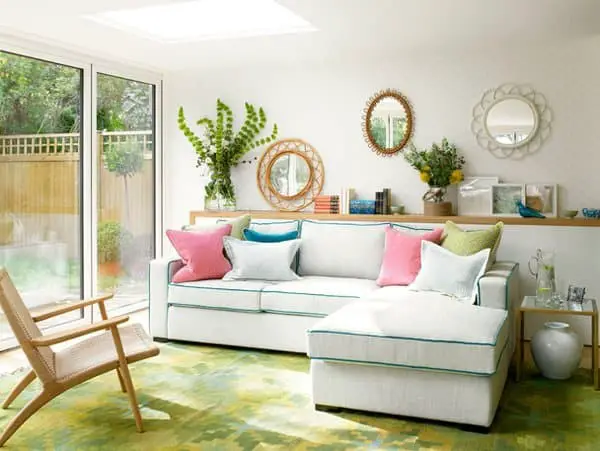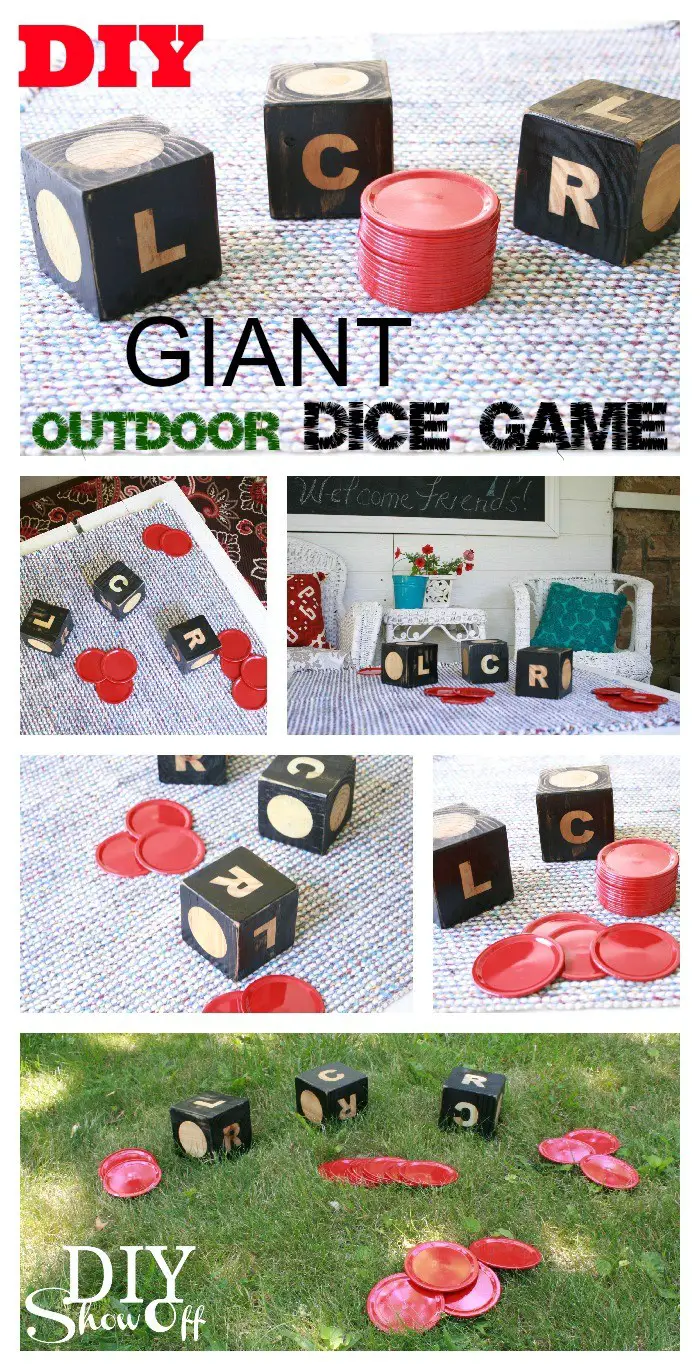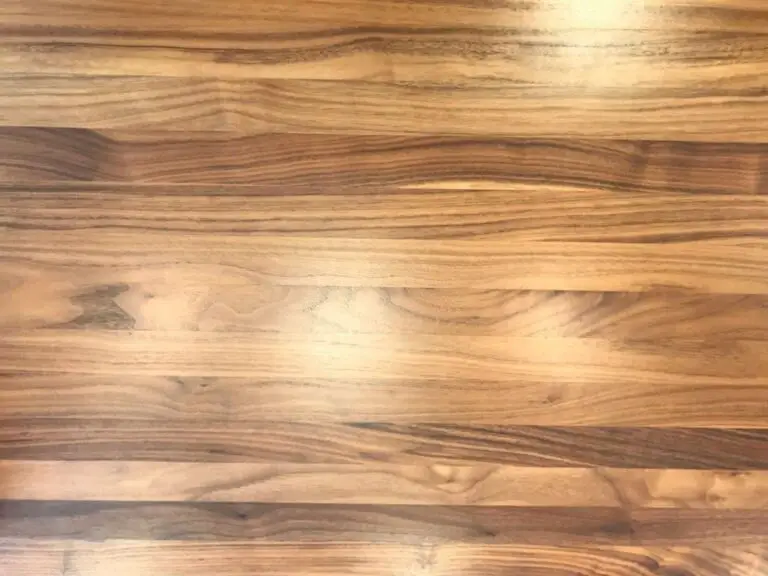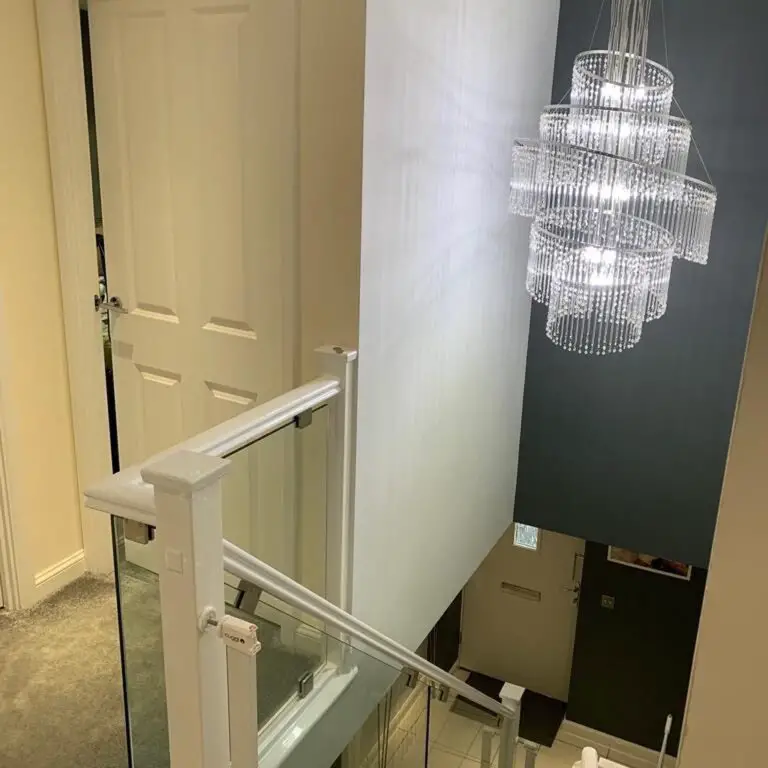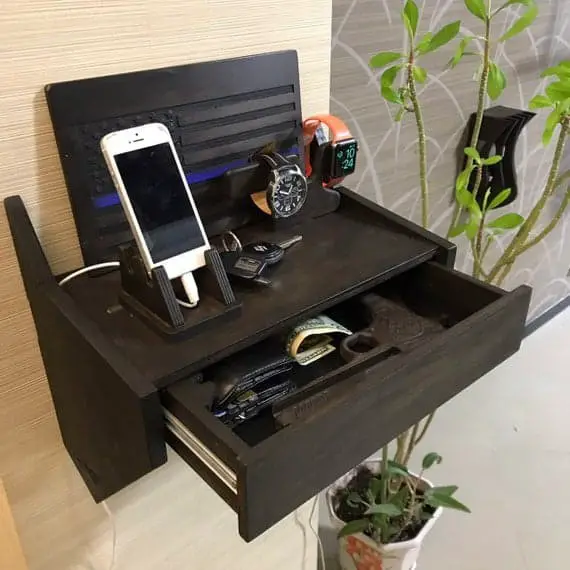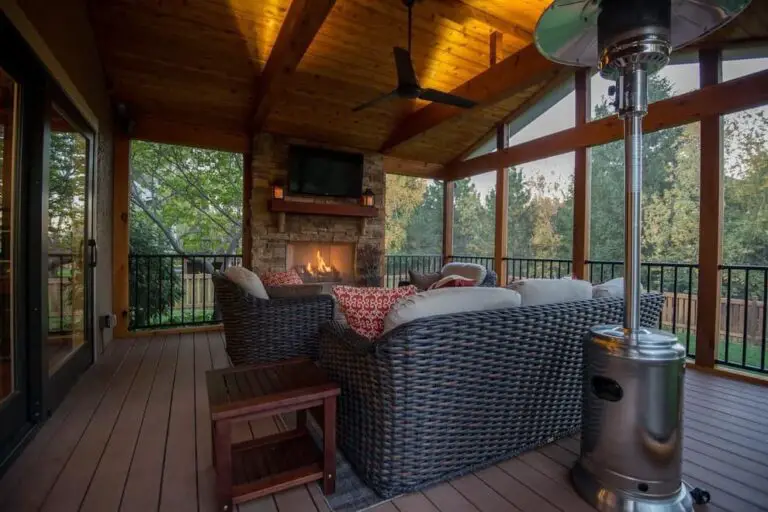Backsplash Alternatives: 19 Unique Ideas To Spruce Up Your Kitchen
Looking to revamp your kitchen’s focal point without sacrificing style or budget? You’re in the right place! In this article, we’ll explore 19 innovative alternatives to traditional backsplash tile that will add personality and flair to your cooking space. From rustic wood paneling to mirrored accents, each option is designed to inspire and surprise. Browse through our photo gallery and discover new ways to elevate your kitchen’s visual appeal.
Alternatives To Backsplash Tile
Beadboard.
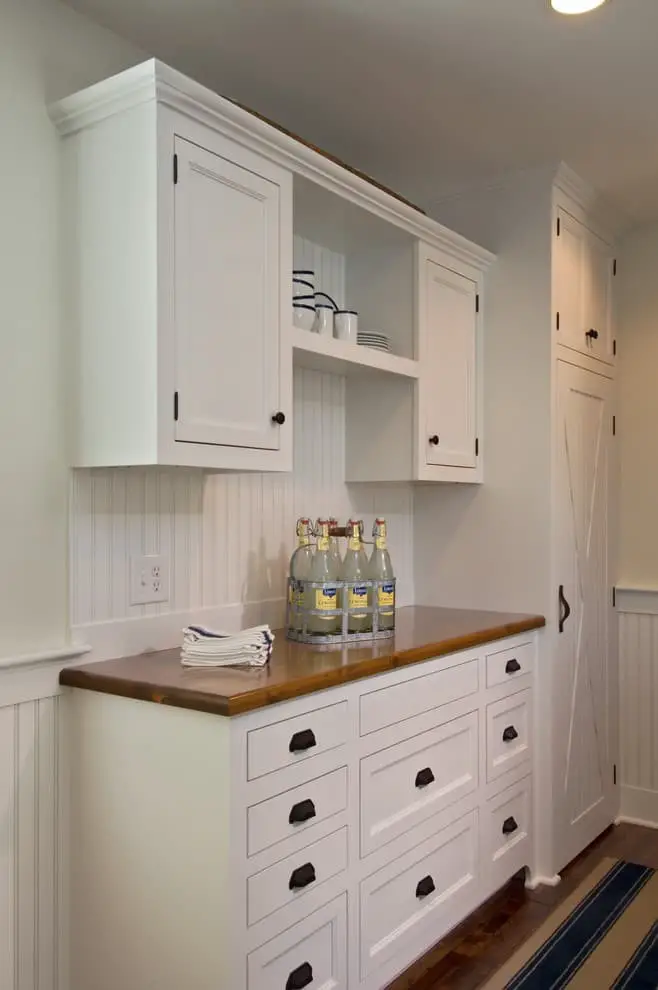
When it comes to giving your kitchen or bathroom a modern makeover, beadboard can be an attractive and practical solution. This type of wainscoting, characterized by vertical wood panels joined by horizontal strips of wood called beadings, offers an easy-to-install alternative to tile. Not only is it suitable for walls, but also ceilings.
Beadboard is available in a range of woods, including pine, poplar, and maple, as well as MDF (medium-density fiberboard), which boasts improved stability compared to particle board. This makes it less prone to warping or shrinking due to changes in temperature and humidity. You can opt for either unfinished or finished beadboard, depending on your budget and installation preferences.
Unfinished beadboard provides a cost-effective solution that requires more work upfront, whereas finished beadboard is ready to install straight away, albeit at a higher price point.
Brick.

The timeless appeal of a brick backsplash lies in its understated sophistication. By incorporating this classic design element into your kitchen, you can effortlessly infuse your space with character and warmth without veering too far from traditional aesthetics. Moreover, its practical benefits – ease of cleaning and maintenance – make it an appealing choice for homeowners seeking a low-fuss solution.
For those who yearn for a more nostalgic look, brick backsplashes offer a tried-and-true path to achieving that desired ambiance.
Bright Bottle Caps.

The humble bottle cap has proven to be an unexpected gem for kitchen backsplashes. Initially, I was unconvinced by its potential, but after witnessing it in person, I was won over. The versatility of bottle caps is what truly sets them apart – they come in a kaleidoscope of colors and can inject a dash of personality into your kitchen’s design. Moreover, their installation is remarkably straightforward; simply apply adhesive and you’ll be enjoying the unique aesthetic they bring to your space.
Burlap.
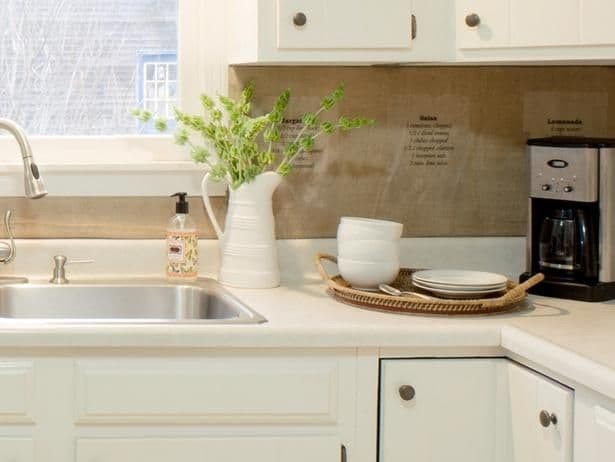
While burlap may not be the first material that comes to mind when thinking of kitchen design, it’s an affordable, accessible option that can add significant texture and visual interest to your space. Its natural fibers also make it a practical choice for protecting walls from splatters and spills. Plus, its versatility allows you to easily customize its appearance by adding paint or fabric trim for a more polished look, or using large tiles to create a modern backsplash design.
By choosing burlap as an alternative to traditional backsplashes, anyone can give their kitchen a budget-friendly makeover that’s both easy and effective.
Chalkboard paint.

Transforming your kitchen with chalkboard paint is an innovative approach that not only adds a splash of personality but also provides a functional space for jotting down recipes or leaving notes. The versatility of this paint lies in its availability in a wide range of vibrant colors, allowing homeowners to select the perfect hue that complements their kitchen’s aesthetic and personal style.
Decoy Decals.
Add a touch of whimsy to your kitchen without sacrificing style or budget with decoy decals. These removable stickers allow for effortless updates and endless creative possibilities.
Gallery Wall.
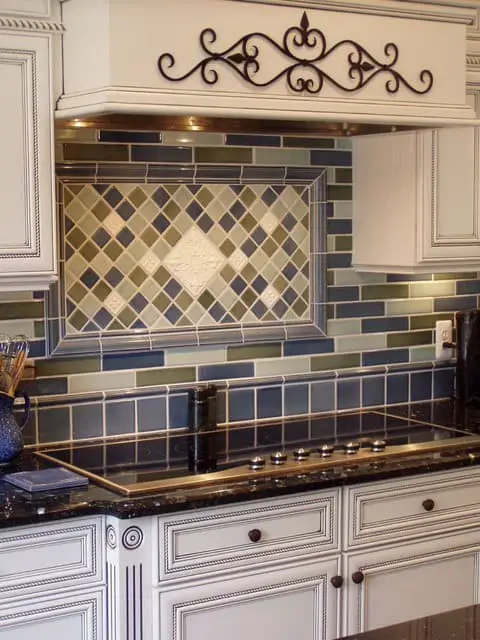
One way to infuse your kitchen with personality is by creating a visually appealing gallery wall. You can place this above your backsplash or in an empty space on another wall, depending on the layout and aesthetic you’re going for. To get started, gather some frames that fit your style – they can be rustic, modern, or anything in between. Then, fill those frames with fun prints, photos, or other decorative elements that add a pop of color or pattern to the space.
This approach allows you to bring some visual interest into your kitchen without having to undertake any major renovation projects.
Glass.

While traditional tile has its own charm, glass is a fantastic alternative that can add a touch of sophistication to your kitchen. Its ease of cleaning and maintenance makes it an attractive option for homeowners who value practicality. Moreover, the variety of colors and styles available means you can choose a glass surface that perfectly complements your kitchen’s aesthetic.
If you’re particularly fond of tile but want to avoid its more mundane appearance, glass offers a convincing alternative – even offering a tile-lookalike option. One often-overlooked benefit of glass is its ability to reflect light, thereby illuminating your kitchen and creating an airy, open feel.
Mason Jar Mosaic.
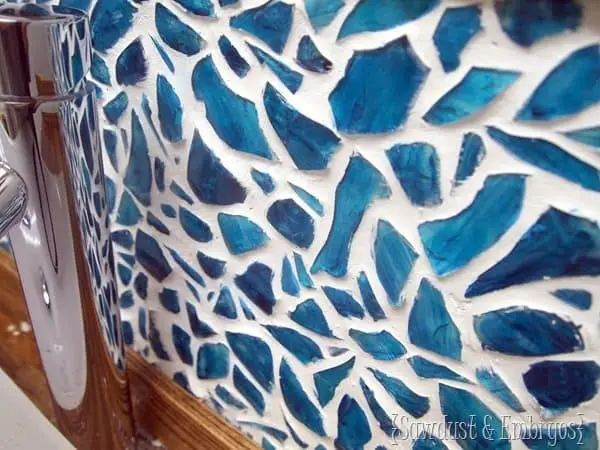
Transform your kitchen backsplash into a stunning work of art by creating a unique mason jar mosaic. This DIY project is surprisingly easy and allows for complete customization to match your home’s decor. To get started, gather the following materials: strong adhesive, tiles or flat marbles, and empty mason jars. Follow these steps to bring your vision to life: Begin by applying a small amount of glue to the back of a tile and carefully placing it in the center of the mason jar lid.
Continue this process until the entire surface is covered, allowing each layer to dry completely before adding the next. Once the tiles are securely in place, it’s time to add the finishing touches. Mix grout according to the manufacturer’s instructions, then spread it evenly across the tiles using a rubber spatula. Wipe away any excess grout with a damp cloth and voilà! Your mason jar mosaic is complete.
Metal.

Metal stands out as a fantastic substitute for glass or tile, boasting durability and simplicity in terms of cleaning. Its versatility is further highlighted by the range of colors and patterns available. Moreover, metal’s adaptability allows it to seamlessly integrate into various designs. It can be used to create stunning backsplashes, accent walls, or even flooring, making it an ideal material for a wide range of spaces.
Mirror.

Imagine gazing into the fairest of them all – not Snow White’s magic mirror, but your very own mirrored backsplash! This clever choice can instantly brighten up and open up any room, thanks to its reflective properties. And the best part? Cleaning is a breeze – just grab some glass cleaner and give it a quick once-over. The only potential drawback is that mirrors may reveal fingerprints and smudges more readily than other materials.
So, if you do choose a mirrored backsplash, be prepared to offer it a little extra TLC when it comes time for cleaning. Despite this minor quibble, mirrors can bring a touch of sophistication and glamour to any space, making them an excellent alternative for backsplashes.
Painted Planks.
Transforming your kitchen’s focal point with an affordable yet striking backsplash option. A simple yet effective DIY project, painting wooden planks or MDF strips in your desired hues and securing them to the wall can inject a dash of personality into your kitchen. And if you’re not feeling crafty, pre-made painted plank backsplashes are readily available for installation. This budget-friendly solution enables you to elevate your kitchen’s ambiance without incurring significant expenses.
Patterned Plywood.
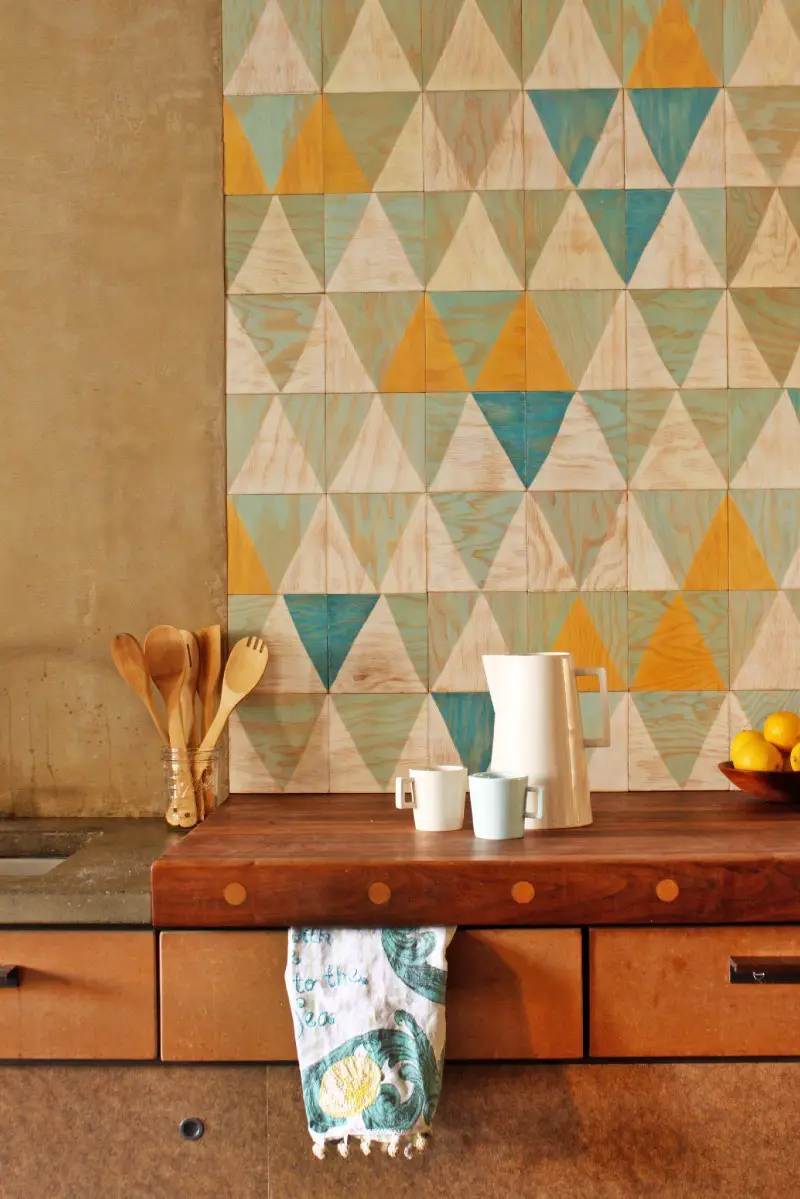
Adding personality to your kitchen doesn’t have to break the bank. Patterned plywood is a great way to do just that. This versatile material is easy to install and widely available at most home improvement stores, making it an attractive alternative to tile backsplashes. Plus, its budget-friendly price tag means you can stay within your means without sacrificing style. For a unique touch, consider using patterned plywood as an accent wall in your kitchen.
This subtle yet effective design element adds visual interest without overwhelming the space. And because it’s so easy to install and cut to fit any size or shape, you can get creative with the design without worrying about complicated installation processes. The best part? You won’t have to break the bank to achieve this look. Patterned plywood is significantly less expensive than tile, making it a practical choice for homeowners on a budget.
At your local hardware store, you can find this affordable material and start transforming your kitchen today.
Peel-and-Stick Patterns.
For homeowners seeking a budget-friendly yet stylish solution for their kitchens, peel-and-stick patterns are an excellent alternative to traditional backsplashes. Not only do they offer a wide range of colors and styles to suit individual tastes, but they’re also remarkably easy to install, requiring no specialized expertise or labor-intensive measures.
What’s more, these adhesive-backed designs are a fraction of the cost of their tile counterparts, making them an attractive option for those looking to revamp their kitchen without breaking the bank.
Pegboard.

Pegboard presents a compelling alternative to traditional backsplashes. Its ease of installation and widespread availability at hardware stores make it an attractive choice for homeowners and DIY enthusiasts alike. What’s more, pegboard offers a range of colors and can be custom-cut to fit any space, ensuring a seamless integration into your design. This versatile material can be used not only as a backsplash but also to create functional shelves or even striking wall art.
Its adaptability and practicality make it an excellent option for those seeking a unique and low-maintenance solution.
Stencils.

Stenciling provides an innovative way to give your kitchen a distinctive appearance, offering a viable alternative to traditional backsplashes. Craft stores typically carry a variety of stencils that are simple to utilize. The process involves applying paint over the stencil and subsequently removing it. For a more long-lasting solution, reusable stencils are also available, designed to withstand multiple uses for years to come.
Before embarking on your project, it’s essential to practice on a piece of paper first, allowing you to master the technique before transforming your backsplash with paint.
Stone.

When it comes to backsplashes, stone is an excellent choice due to its durability and ease of cleaning. This makes it an ideal option for busy kitchens where aesthetics meet functionality. For those seeking something more distinctive, pebbles or mosaic tile can be great alternatives. However, keep in mind that stone backsplashes can come with a higher price tag, so it’s essential to gather multiple quotes from contractors before making a final decision.
Window.

A window can be an unconventional yet effective alternative to traditional backsplashes. By allowing natural light to flood into your kitchen, it can create a brighter and more spacious atmosphere. This concept is particularly appealing to cooking enthusiasts who value being able to keep an eye on their family or pets while they’re busy in the kitchen. However, it’s essential to consider the potential drawbacks before making a switch.
Windows can attract dust, which may require additional cleaning efforts. If privacy is a concern, you might want to explore options like frosted glass or window film. Despite these minor limitations, a window backsplash can be an innovative solution for those willing to adapt.
Wood.
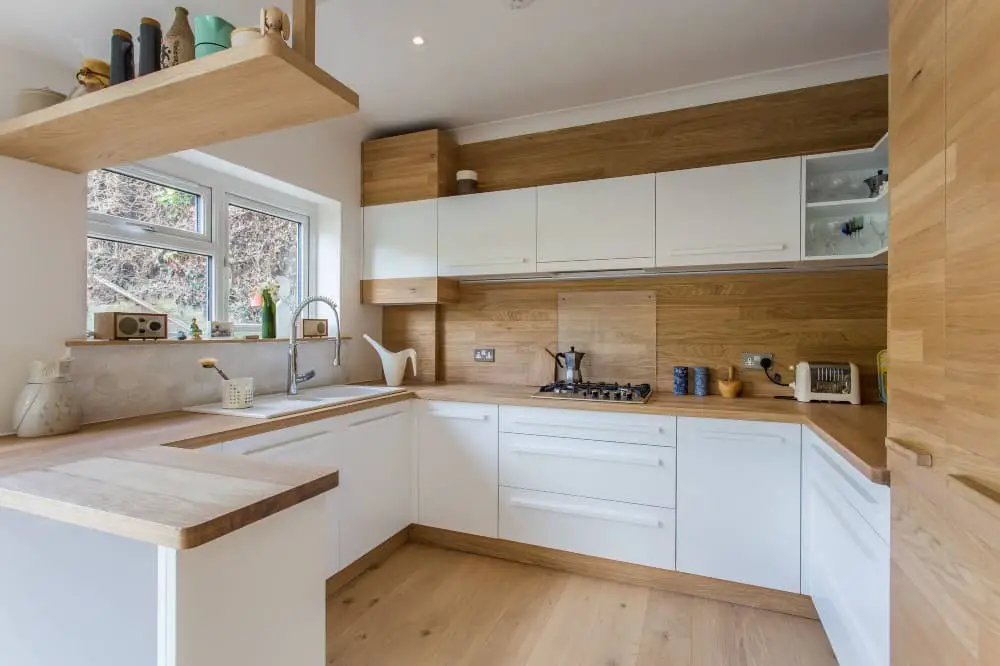
Wood remains a timeless choice for kitchen backsplashes, capable of imparting a warm, rustic ambiance. Its durability allows for effortless cleaning and upkeep, yet its porous nature means that proper sealing is crucial to prevent water damage. A well-sealed wood backsplash can add character and charm to your kitchen, making it an attractive option for homeowners seeking a unique look.
FAQs
Can you have a kitchen with no backsplash?
When considering whether to go without a backsplash in your kitchen, it’s essential to weigh the potential benefits against the potential drawbacks. One of the primary functions a backsplash serves is to protect your walls from splatters and spills, making it a practical consideration. Additionally, a backsplash can also add a decorative touch to your space, introducing a pop of color or pattern that can elevate the overall aesthetic.
The type of countertops you’ve chosen should also influence your decision. If you’re working with a material that’s prone to staining, such as marble or limestone, installing a backsplash becomes even more crucial to preserve the integrity of your walls. On the other hand, if you have a countertop material that’s less susceptible to damage, you may be able to get away without a backsplash. Ultimately, the decision comes down to balancing the style and functionality of your kitchen.
A minimalist space might benefit from a sleek, understated backsplash, while a more traditional kitchen could use a busier design to create visual interest. If you’re still unsure about which path to take, consider consulting with a kitchen designer or contractor who can help you navigate the pros and cons and make an informed decision that suits your unique space.
What is the easiest kitchen backsplash to install?
The most straightforward kitchen backsplash to install is undoubtedly the peel and stick variety. Its ease of installation stems from its self-adhesive properties, requiring merely a gentle peel-off motion followed by a simple stick-on application. However, there are some essential considerations to keep in mind when undertaking this process.
Firstly, it’s crucial to ensure that your surface is spotlessly clean and dry, as any residual grease or dirt may hinder the backsplash’s ability to adhere properly. Secondly, patience is key – don’t rush the installation! Begin by carefully peeling off a small section of the backing material, then line up the edge of the backsplash with the edge of your countertop or wall. Once aligned, slowly remove the remainder of the backing and apply the backsplash at a leisurely pace.
Are Splashbacks cheaper than tiles?
While tiles have long been a staple in kitchens and bathrooms, offering a practical and stylish solution for protecting walls from splashes, the popularity of splashbacks has risen significantly in recent years. But what sets these two apart? Which one offers better value for your money?
Can shiplap be used as a backsplash?
While it may not be a traditional choice for backsplashes, shiplap can indeed bring a charming rustic touch to kitchens. If you’re considering this unique look, there are a few factors to keep in mind. Firstly, the thicker material of shiplap means your cabinets will need to accommodate its dimensions. Secondly, unlike some other materials, shiplap lacks built-in adhesive, so construction adhesive or Liquid Nails will be necessary for secure attachment.
Despite these minor considerations, installing shiplap as a backsplash is relatively straightforward. Measure and cut the boards to fit your space, then attach them using adhesive. After installation, simply caulk any gaps that may appear and finish with paint or stain to match your kitchen’s existing aesthetic.
Can quartz be used as backsplash?
Quartz’s unique beauty makes it a coveted addition to any home, capable of elevating its aesthetic appeal. While most often utilized for countertops, this versatile material can also be employed for backsplashes. Notably, quartz boasts exceptional heat resistance and effortless cleanability, rendering it an exemplary choice for kitchens where functionality meets style.
Can beadboard be used as a backsplash?
To turn your kitchen into a stunning space with an easy-to-clean backsplash, the answer is indeed yes! Beadboard is an excellent choice. To get started, define the aesthetic you want to achieve. Do you envision a rustic country kitchen, a beach-inspired vibe, or something more modern? Once you have a clear style in mind, choose the beadboard that best fits your vision. Before making any purchases, take precise measurements of the area where you’ll be installing the backsplash.
This will ensure you buy the right amount of beadboard for a seamless installation.
Conclusion
Ultimately, the plethora of backsplash alternatives available today offers homeowners the flexibility to select an option that aligns with their unique style and preferences. From timeless classics to cutting-edge designs, the possibilities are endless. While it’s essential to seek the guidance of a professional to ensure the best possible outcome for your home renovation project, this wealth of choices ensures that you can find the perfect backsplash to suit your vision.
We appreciate your interest in our article and hope that it has provided valuable insights to inform your decision-making process.
Related Posts
To pursue a career as a kitchen and bath designer, you’ll need to follow a specific pathway. The first step is to gain a solid understanding of design principles, including spatial planning, color theory, and materials selection. This foundation will enable you to effectively communicate with clients, envisioning their ideal kitchen or bathroom space.
Next, consider formal education in interior design or architecture, which can provide valuable insights into building codes, zoning regulations, and project management. Alternatively, you may choose to build your skills through online courses, workshops, or apprenticeships under the guidance of experienced professionals. As you progress, stay up-to-date with industry trends, technological advancements, and best practices by attending conferences, webinars, and networking events.
Finally, join professional associations like the National Kitchen and Bath Association (NKBA) to access valuable resources, connect with peers, and stay informed about market developments.

